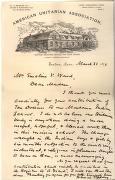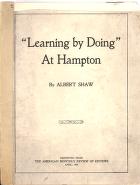|

"The Deerfield Captive"

Frontpage of Greenfield Gazette & Franklin Herald newspaper

Thank you letter to Emeline Ward for contribution to Amer. Unitarian Assoc. to benefit Montana Industrial School for Crow Indian

"Learning By Doing At Hampton"
|
Summary and Objective
Students will understand that during the 19th Century, there was a conflict arising between Native Americans and American citizens moving further westward. Students will use primary sources and web research to discover why the US government had to settle this conflict, and the various ways that the government settled the conflict by addressing the Native Americans.
Teaching Plan
Step 1.
1. The teacher will introduce the lesson and discuss the difficulties that the government faced between the country’s original inhabitants, the Native Americas, and the spread of more American citizens westward. The Native Americans were eventually seen as the “Indian problem” that must be settled in order to continue westward settlement and nation building. Students will view primary sources from the Collection and from the Westward Expansion website to formulate reasons for why the government needed to deal with this growing conflict. **Special Instructions for Primary Sources: 1. Frontpage of Greenfield Gazette: Scroll Down to the portion labled, “The Cherokees,” 2. Deefield Captive: View the Cover page (read pages, optional),
Step 2.
Students will brainstorm ideas in small groups once they have viewed the primary sources.
(Possible reasons for government intervention might include: (a) Land/Natural Resource disputes, (b) Fear of native Americans as “savage” and “killers,” (c) To Civilize the people as a humane way to “Americanize” them)
Step 3.
Once students have discussed reasons for why the government must settle this conflict, students will use multiple resources to answer the research question: “How did the US government deal with the “Indian problem” over the 19th century?”
(Suggested ways to deal with the “Indian problem:” Relocation, Assimilation, Violent Conflict)
Suggested Websites to use in Answering the Research Question:
Learning By Doing Primary Source from the Collection, Assimilation Through Education Website, Westward Expansion Website, PBS Indian Diaries Website,
History Channel Website, Native American Encyclopedia Website
Step 4.
Once students have concluded their research, the class should discuss their findings. Questions to consider: Why did the government solve the “Indian problem” in the ways that they did? Are there patterns to the ways in which the government solved the “Indian problem?” How did American citizen views of the “Indians” differ over time? Was the way to solve the “Indian problem” fair?
Step 5.
Possible Lesson Extensions: Research Helen Hunt Jackson, a native of Amherst, MA and her work regarding the government’s treatment of Native Americans (see link below for Mass Moments).
|




